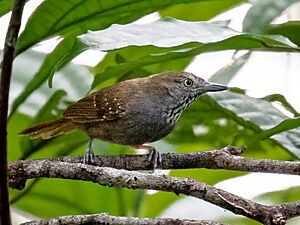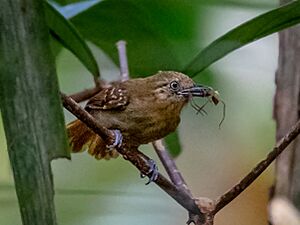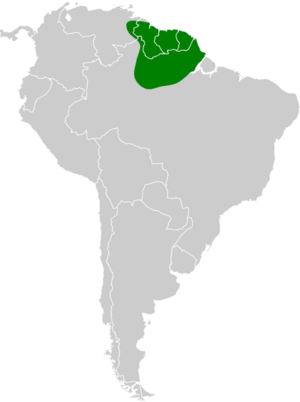Brown-bellied stipplethroat facts for kids
Quick facts for kids Brown-bellied stipplethroat |
|
|---|---|
 |
|
| A male at Manaus, Amazonas state, Brazil. | |
 |
|
| A female at Manaus, Amazonas state, Brazil. | |
| Conservation status | |
| Scientific classification | |
| Genus: |
Epinecrophylla
|
| Species: |
gutturalis
|
 |
|
| Synonyms | |
|
Myrmotherula gutturalis |
|
The brown-bellied stipplethroat is a small bird found in parts of South America. It was once known as the brown-bellied antwren. This bird belongs to the "typical antbirds" family, called Thamnophilidae. You can find it in countries like Brazil, French Guiana, Guyana, Suriname, and Venezuela.
Contents
About the Brown-bellied Stipplethroat
What's in a Name?
The brown-bellied stipplethroat was first described by two English bird experts, Philip Sclater and Osbert Salvin, in 1881. They gave it the scientific name Myrmotherula gutturalis.
Later, in 2006, scientists studied its genes and calls. They decided to move this bird and seven others to a new group called Epinecrophylla. All these birds were then called "stipplethroats." This new name helps show a special feature they share and tells them apart from other antwrens.
The brown-bellied stipplethroat is a monotypic species. This means it does not have different subspecies or types.
How to Spot One
The brown-bellied stipplethroat is a small bird, about 9.5 to 10.5 centimeters (3.7 to 4.1 inches) long. It weighs around 7.5 to 9.5 grams (0.26 to 0.34 ounces).
- Males:
- They have a mostly gray face and a black throat with white spots.
- Their head, upper body, tail, and flight feathers are olive-brown.
- Their wing feathers are darker olive-brown with small white tips.
- Their chest and upper belly are gray, turning a bit clay-colored towards the tail.
- Females:
- They have a pale brownish-buff face and throat.
- Their head and upper body are yellowish olive-brown.
- Their tail is reddish.
- Their wing feathers have pink or pinkish-buff tips.
- Their underside is pale brownish-buff, darker on the sides and under the tail.
Young birds have large spots on their wing feathers. These spots almost form a continuous band.
Where They Live
You can find the brown-bellied stipplethroat in eastern Venezuela. Its range goes east through the countries known as the Guianas. It also extends south into Brazil, reaching the Amazon River.
This bird lives in the lower parts of terra firme evergreen forest. This type of forest is on higher ground that doesn't flood. They can be found from sea level up to 1,000 meters (3,300 feet) high. However, they usually stay below 600 meters (2,000 feet).
Brown-bellied Stipplethroat Behavior
Staying in One Place
Scientists believe the brown-bellied stipplethroat lives in the same area all year round. It does not migrate to other places.
What They Eat
We don't know all the details about what brown-bellied stipplethroats eat. But we do know their diet includes insects and spiders.
They usually look for food alone or in pairs. Often, they join a mixed-species feeding flock. This is a group of different bird species feeding together. They mostly search for food in the lower parts of the forest. Some studies say they rarely go higher than 9 meters (30 feet) above the ground. But others have seen them feeding as high as 15 meters (49 feet). They often look for food in tangled vines, hanging dead leaves, and other plant bits caught in the vines.
How They Defend Their Space
Male brown-bellied stipplethroats have a special way to show off to each other. They display from branches less than 1 meter (3 feet) apart. They puff up the feathers on their back and flare their throat feathers. They also sway back and forth and make continuous sounds.
Family Life
The breeding season for the brown-bellied stipplethroat is not fully known. It seems to be different depending on the area. In French Guiana, they nest in February and March. In Brazil, they might nest from May to December.
Nests found in French Guiana were deep pouches. They were made of plant and fungal fibers and dead leaves. These nests hung from a thin branch fork about 1.5 meters (5 feet) above the ground. One nest in Brazil was a round ball of twigs and leaves. It was low to the ground in a bush. They usually lay two eggs.
We don't know how long the eggs take to hatch. But the young birds leave the nest about 11 days after hatching. Both parents help incubate the eggs. They also care for and feed the baby birds.
Their Sounds
The song of the brown-bellied stipplethroat is described as a "very high, thin, shivering, descending 't-srrrrrruw'."
Their calls include:
- A "distinctive 'chip' followed by about five notes that go up and down in pitch and loudness."
- A "single downslurred note."
- A "rubbery rattle that rises and falls in pitch and loudness."
Conservation Status
The IUCN (International Union for Conservation of Nature) checks on how safe different species are. In 2004, they first said the brown-bellied stipplethroat was of "Least Concern." This means it was not in danger. Then, in 2012, they listed it as "Threatened." But since 2022, it's back to "Least Concern."
This bird has a very large area where it lives. There are more than one million adult birds. However, this number is thought to be going down.
Some possible dangers to the species include logging (cutting down trees) and mining. These activities seem to be increasing. But their impact on the overall forest habitat is currently thought to be low. However, cutting down forests to make space for farming might be a bigger problem in some local areas.
The brown-bellied stipplethroat is considered fairly common throughout its range. It lives in several protected areas. It also lives in large areas of untouched forest. Even though these areas are not officially protected, they are not currently at high risk of being developed.


